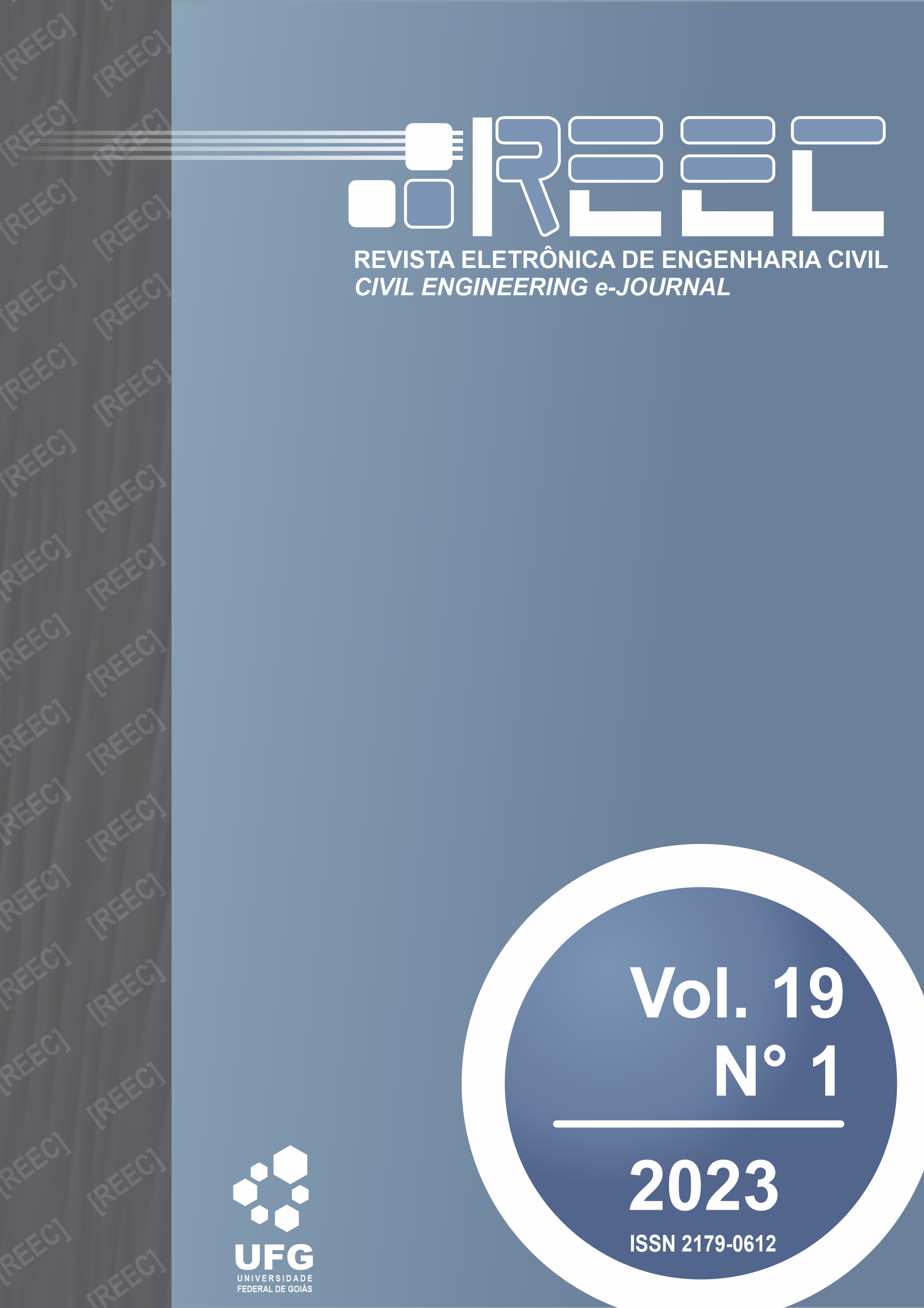APLICAÇÃO DO DESIGN GENERATIVO NO DIMENSIONAMENTO DE BARREIRAS ACÚSTICAS
DOI:
https://doi.org/10.5216/reec.v19i1.76008Palavras-chave:
Barreiras acústicas, Ruído de tráfego, Design generativo, Programação visual, Algoritmos evolutivosResumo
RESUMO: O controle do ruído de tráfego rodoviário próximo a zonas habitadas pode ser alcançado com a instalação de barreiras acústicas. Entretanto, o processo de projeto desses elementos demanda muito tempo e energia do projetista em um ciclo de tentativa e erro. Visando automatizar parte dessa dinâmica, especialmente em sua fase inicial, este trabalho propõe um modelo de dimensionamento e avaliação de desempenho para barreiras acústicas, criado por meio de programação visual e do design generativo. Assim, a partir de um cenário hipotético – um terreno lindeiro à uma rodovia – buscou-se encontrar os pontos com a maior atenuação sonora possível após a inserção de uma barreira fina, semi-infinita e em condições de campo livre. As análises, realizadas com um evolutionary solver, foram divididas por altura da barreira e tipo de fonte sonora (puntiforme e linear). Os valores da atenuação foram calculados separadamente para cada altura do receptor e banda de frequência da onda sonora (de 63 Hz a 8 kHz). Para efeito de simplificação, as características materiais e variáveis climáticas não foram consideradas. Os resultados demonstrados nos gráficos correspondem às expectativas anteriores às simulações – quanto mais elevado o receptor em relação à barreira, menor a atenuação sonora – comprovando a eficiência do método utilizado, e os melhores valores puderam ser selecionados facilmente, com a visualização das soluções feita em tempo real.
ABSTRACT: Controlling road traffic noise close to inhabited areas can be achieved by installing sound barriers. Nonetheless, the design process of such elements requires large amount of time and energy from the designer on a trial and error cycle. Aiming to automate part of this dynamic, especially in its early stages, this paper proposes a sizing and performance evaluation model for noise barriers, created through visual programming and generative design. Thus, from a hypothetical scenario – a terrain adjacent to a highway – it was sought to find the points with the greatest possible attenuation after the insertion of a thin and semi-infinite barrier in free field conditions. Performed with an evolutionary solver, the analyses were organized by the barrier height and type of sound source (point or line sources). Attenuation values were calculated separately for each receiver height and frequency octave band (from 63 Hz to 8 kHz). For simplification purposes, material characteristics and weather effects were not considered. The results shown in the graphs correspond to expectations prior to the simulations – the higher the receiver in relation to the barrier, the lower the sound reduction – proving the efficiency of the method used. The best values could be easily selected and the visualization of the solutions made in real time.
Downloads
Referências
ASSOCIAÇÃO BRASILEIRA DE NORMAS TÉCNICAS. NBR 10152: Acústica — Níveis de pressão sonora em ambientes internos a edificações. Rio de Janeiro. 2017, 21 p. Versão corrigida 2020.
______ NBR 10151: Acústica - Medição e avaliação de níveis de pressão sonora em áreas habitadas - Aplicação de uso geral. Rio de Janeiro. 2019. 25 p. Versão corrigida 2020.
BISTAFA, S. Acústica aplicada ao controle do ruído. São Paulo: Blucher, 2018, 436 p.
BRASIL. Lei nº 13.913, de 25 de novembro de 2019. Altera a Lei nº 6.766, de 19 de dezembro de 1979, para assegurar o direito de permanência de edificações na faixa não edificável contígua às faixas de domínio público de rodovias e para possibilitar a redução da extensão dessa faixa não edificável por lei municipal ou distrital. Disponível em: <http://www.planalto.gov.br/ccivil_03/_ato2019-2022/2019/lei/L13913.htm>. Acesso em: 06 maio 2023.
CAETANO, I.; SANTOS, L.; LEITÃO, A. Computational design in architecture: Defining parametric, generative, and algorithmic design. Frontiers of Architectural Research, v. 9, n. 2, jun. 2020. p. 287-300. DOI: https://doi.org/10.1016/j.foar.2019.12.008. Disponível em: <https://www.sciencedirect.com/science/article/pii/S2095263520300029?via%3Dihub>. Acesso em: 06 maio 2023.
CRUZ, R. G. da.; ARCIPRESTE, C. M.; PINHEIRO, R. L.; RIBAS, R. A. de J. Generative design: information flow between genetic algorithm and parametric design in a steel structure construction. Ambiente Construído, Porto Alegre, v. 21, n. 4, p. 271–289, out./dez. 2021. DOI: https://doi.org/10.1590/s1678-86212021000400569. Disponível em: <http://www.scielo.br/j/ac/a/f5dkBmGvDYV8hDNgxHRXxYz/?lang=en>. Acesso em: 06 maio 2023.
CELANI, G. Algorithmic Sustainable Design: uma visão crítica do projeto generativo. Resenhas Online, ago. 2011. Disponível em: <https://www.vitruvius.com.br/revistas/read/resenhasonline/10.116/3995>. Acesso em: 06 maio 2023.
GENERATIVE. In: CAMBRIDGE DICTIONARY. Cambridge: Cambridge University Press, 2021. Disponível em: <https://dictionary.cambridge.org/us/dictionary/english/generative>. Acesso em: 31 maio 2022.
GIRALDO-CLAVIJO, P.; YANG, J. J. A comparative study of insertion loss of traffic noise barriers in Georgia. In: International Conference on Transportation and Development 2020. American Society of Civil Engineers, Siattle, Washington, 2020. p. 131-139. DOI: 10.1061/9780784483138.012. Disponível em: <https://ascelibrary.org/doi/10.1061/9780784483138.012>. Acesso em: 06 maio 2023.
HANNAH, L. The Effect of Environment on Sound Propagation. New Zealand Acoustics, v. 20, n. 1, 2007a. p. 3-9. Disponível em: <https://www.acoustics.org.nz/sites/www.acoustics.org.nz/files/journal/pdfs/Hannah_L_NZA2007_b.html>. Acesso em: 13 mar. 2023.
______ Wind and Temperature Effects on Sound Propagation. New Zealand Acoustics, v. 20, n. 2, 2007b. p. 22-29. Disponível em: <https://www.acoustics.org.nz/sites/www.acoustics.org.nz/files/journal/pdfs/Hannah_L_NZA2007_a.html>. Acesso em: 06 maio 2023.
HUANG, S.; SUN, Z.; Liu, H.; WANG, Y.; YUAN, M. Key Points of Acoustic Consultation for Highway Noise barrier Design Optimization. In: E3S Web of Conferences. Anais... v. 145, fev. 2020. p. 02008. DOI: https://doi.org/10.1051/e3sconf/202014502008. Disponível em: <https://www.e3s-conferences.org/articles/e3sconf/abs/2020/05/e3sconf_iaecst2020_02008/e3sconf_iaecst2020_02008.html>. Acesso em: 01 maio 2023.
INTERNATIONAL ORGANIZATION FOR STANDARDIZATION. ISO 9613/2: Acoustics — Attenuation of sound during propagation outdoors — Part 2: General method of calculation. Genebra. 1996, 18 p.
KAWAKITA, C. Y. Medição do ruído de tráfego na rodovia SP 270 e avaliação da satisfação quanto ao conforto acústico de seus moradores. 174 p. Dissertação (Mestrado) - Escola Politécnica, Universidade de São Paulo. São Paulo, 2008. DOI: 10.11606/D.3.2008.tde-30052008-105650. Disponível em: < https://www.teses.usp.br/teses/disponiveis/3/3146/tde-30052008-105650/pt-br.php>. Acesso em: 06 maio 2023.
KURZE, U. J.; ANDERSON, G. S. Sound attenuation by barriers. Applied Acoustics, v. 4, n. 1, p. 35-53, jan. 1971. DOI: https://doi.org/10.1016/0003-682X(71)90024-7. Disponível em: <https://www.sciencedirect.com/science/article/pii/0003682X71900247>. Acesso em: 06 maio 2023.
MAEKAWA, Z. Noise reduction by screens. Applied Acoustics, v. 1, n. 3, p. 157-173, jul. 1968. DOI: https://doi.org/10.1016/0003-682X(68)90020-0. Disponível em: <https://www.sciencedirect.com/science/article/pii/0003682X68900200>. Acesso em: 05 maio 2023.
MELLO, R. B. D. Do Projeto Paramétrico ao Projeto Generativo – Parte 1: O que é projeto generativo. Mundo AEC - Autodesk Brasil, 19 jan. 2017a. Disponível em: <https://blogs.autodesk.com/mundoaec/projeto-generativo-parte-1/>. Acesso em: 06 maio 2023.
______ Do Projeto Paramétrico ao Projeto Generativo – Parte 2: Projeto Algorítmico e Dynamo (com apostila). Mundo AEC - Autodesk Brasil, 02 fev. 2017b. Disponível em: <https://blogs.autodesk.com/mundoaec/projeto-generativo-parte-2/>. Acesso em: 05 maio 2023.
MITCHELL, W. J. The Theoretical Foundation of Computer-Aided Architectural Design. Environment and Planning B: Planning and Design, Londres, v. 2, n. 2, p. 127-150, 01 dez. 1975. DOI: https://doi.org/10.1068/b020127. Disponível em: <https://journals.sagepub.com/doi/abs/10.1068/b020127>. Acesso em: 04 maio 2023.
MONKS, M.; OH, B. M.; DORSEY, J. Audioptimization: goal-based acoustic design. IEEE Computer Graphics and Applications, v. 20, n. 3, p. 76- 90, May./June 2000. DOI: 10.1109/38.844375. Disponível em: <https://ieeexplore.ieee.org/abstract/document/844375?casa_token=Vm6OPGl6_hsAAAAA:dsDczH-_cvQoMC-VLNFCcW6gcYQrxYlO5cUaICN9Nk205hLsbyf10w6n7Spo0HTQtaR3WTTm87k>. Acesso em: 04 maio 2023.
NAGY, D. Evolving design. Medium, 26 jan. 2017. Disponível em: <https://medium.com/generative-design/evolving-design-b0941a17b759>. Acesso em: 6 maio 2023.
NORTON, C. W. Changing space and sound: parametric design and variable acoustics. 139 p. Thesis (Master of Building Science) - University of Southern California, School of Architecture. Los Angeles, 2013. Disponível em: < https://www.proquest.com/openview/e8581a5e9662f509d373ab0a92db6d7d/1?pq-origsite=gscholar&cbl=18750>. Acesso em: 06 maio 2013.
PARAMETER. In: LEXICO.COM. Oxford: Oxford University Press (OUP), 2021. Disponível em: <https://www.lexico.com/definition/parameter>. Acesso em: 27 abr. 2022.
SHIFFMAN, D. Chapter 9. The Evolution of Code. The Nature of Code, 6 dez. 2012. 521 p. Disponível em: <https://natureofcode.com/book/chapter-9-the-evolution-of-code/>. Acesso em: 22 maio 2020.
SILVA, J. R. A. Caracterização do ruído emitido por veículos rodoviários num troço da EN109 em Vagos. Aveiro, 2009. Dissertação (Mestrado) - Departamento de Engenharia Civil, Universidade de Aveiro (Portugal). Disponível em: < https://core.ac.uk/download/pdf/15562618.pdf>. Acesso em: 06 maio 2023.
SPAETH, A. B.; MENGES, A. Performative Design for Spatial Acoustics: concept for an evolutionary design algorithm based on acoustics as design driver. In: Conference on Education in Computer Aided Architectural Design in Europe (eCAADe), 21-24 sep. 2011, Ljubljana. Anais: Respecting fragile places : proceedings of the 29th Conference on Education in Computer Aided Architec tural Design in Europe. Ljubljana, Slovenia: 2011. 982 p. p. 461-468. Disponível em: <http://papers.cumincad.org/data/works/att/eCAADe_2011-lowres.pdf#page=463>. Acesso em: 06 maio 2023.
VELOSO, G. P.; OLIVEIRA, D. M.; RIBEIRO, C. RIBEIRO, S. Design generativo aplicado às estruturas: Otimização do plano de corte dos painéis de tela soldada em paredes de concreto. In: 4° Congresso Português de Building Information Modelling. 2020. Anais... p. 361-370. DOI: https://doi.org/10.21814/uminho.ed.32.30. Disponível em: < https://ebooks.uminho.pt/index.php/uminho/catalog/view/32/132/1643-1>. Acesso em: 06 maio 2023.
VENÂNCIO, R. Sombreamento com iluminação: desenvolvimento e teste de modelo paramétrico para facilitar o projeto de proteções solares. Ambiente Construído, Porto Alegre, v. 20, n. 4, p. 59-77, out./dez. 2020. DOI: https://doi.org/10.1590/s1678-86212020000400460. Disponível em: <http://www.scielo.br/j/ac/a/rch8V4zy5Cx5N5Wv3P5v4Zy/?lang=pt>. Acesso em: 05 maio 2023.
XIAO, Y.; LAI, H.; LI, Q.; WANG, X.; WANG, X. Improved interference-type sound barriers: Use of hyperbolic phase modulation. Applied Acoustics, v. 161, p. 107186, 1 abr. 2020. DOI: http://www.scielo.br/j/ac/a/rch8V4zy5Cx5N5Wv3P5v4Zy/?lang=pt. Disponível em: <https://www.sciencedirect.com/science/article/pii/S0003682X19309363>. Acesso em: 23 abr. 2023.
ZHANG, J.; LIU, N.; WANG, S. Generative design and performance optimization of residential buildings based on parametric algorithm. Energy and Buildings, v. 244, p. 111033, 1 ago. 2021. DOI: https://doi.org/10.1016/j.enbuild.2021.111033. Disponível em: <https://www.sciencedirect.com/science/article/pii/S0378778821003170>. Acesso em: 05 maio 2023.
Downloads
Publicado
Como Citar
Edição
Seção
Licença
Autores que publicam nesta revista concordam com os seguintes termos: Autores mantém os direitos autorais e concedem à revista o direito de primeira publicação, com o trabalho simultaneamente licenciado sob a Licença Creative Commons Attribution que permite o compartilhamento do trabalho com reconhecimento da autoria e publicação inicial nesta revista.
![[REEC] Revista Eletrônica de Engenharia Civil](https://revistas.ufg.br/public/journals/30/pageHeaderLogoImage_pt_BR.png)



